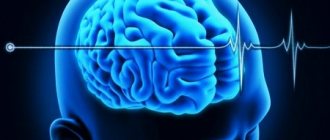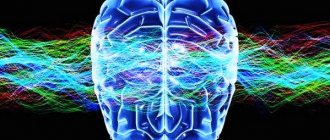© Author: A. Olesya Valerievna, candidate of medical sciences, practicing physician, teacher at a medical university, especially for SosudInfo.ru (about the authors)
Anencephaly is one of the most severe malformations of the fetus, in which the structures of the cerebral hemispheres of the brain are completely absent . The pathology forms in the early stages of pregnancy, when differentiation of the neural tube occurs and the formation of parts of the central nervous system. Most often, a disappointing diagnosis is announced already during the first screening ultrasound examination, in which the specialist does not detect signs of a formed brain, upper part of the skull or soft tissues of the head in the fetus.
Today, congenital defects are increasingly being recorded during routine ultrasound examinations of pregnant women. Diagnoses that leave no hope for a prosperous future for an unborn child plunge future parents into shock, requiring them to make a decision regarding his fate, which in any case will be a difficult test for the whole family, regardless of whether the woman decides to have an abortion or will preserve at least the intrauterine life of her baby.
Anencephaly is classified as a gross malformation in which there is no hope for a favorable outcome. Treatment of this pathology is only symptomatic and only if the child is born. In connection with these circumstances, pregnant women with a similar anomaly, after a detailed explanation of the essence of the problem and the prospects for the baby, are offered a choice between prolonging the pregnancy or terminating it for medical reasons.
Why doesn't the brain develop?
The causes of anencephaly are not precisely understood. This, as experts say, is a multifactorial defect, that is, it occurs spontaneously under the influence of various unfavorable external conditions that cause severe genetic mutations. It is believed that factors such as: increase the risk of gross defects of the nervous system in the fetus:
- unfavorable environmental conditions with the presence of increased concentrations of carcinogenic substances in the air or water (industrial emissions, etc.), increased background radiation;
- intoxication in the early stages of pregnancy (medicines, alcohol, narcotic substances, pesticides, occupational hazards, etc.);
- intrauterine infections (rubella viruses, cytomegalovirus, etc.);
- spontaneous genetic mutations that do not depend on the age of the parents or their lifestyle.
The risk of an anomaly is higher if close blood relatives in the family have already had cases of diagnosis of anencephaly and other gross defects of the central nervous system. Anencephaly is more often recorded in female fetuses.
Often parents who have had to deal with the problem of anencephaly try to find a possible cause of the pathology in order to avoid it in the future during a new pregnancy. It even happens that they blame themselves, although there were no obvious prerequisites for the defect before pregnancy. Their attempts most often turn out to be in vain, and fears regarding a new pregnancy are unfounded, because the risk of recurrence of the anomaly is no more than 5%.
Clinical features and course of anencephaly
Anencephaly is considered a defect with a 100% mortality rate, although the baby can die both inside the womb (about half of all pregnancies with anencephaly) and after birth. Most born sick children live only a few hours, very rarely - up to a week.
drawing (click to enlarge): fetus (left) and newborn children with true anencephaly incompatible with life
History knows of cases where children born with anencephaly lived longer: a girl known as Baby Kay lived for 2.5 years, two more American babies managed to live for almost four years. These cases are isolated and should not be a guideline for a possible successful outcome for confused future parents frightened by the diagnosis.
photo: surviving boy with incomplete anencephaly, part of the brain was formed
Today, the diagnosis of anencephaly based on the results of an ultrasound examination of a pregnant woman is an absolute indication for termination of pregnancy. However, not all women undergo an abortion, even if they are aware of the consequences of continuing the pregnancy. As a rule, abortion is refused due to religious beliefs or due to personal opposition to abortion as such, regardless of the reasons for which it may be due.
Those families who decide to give birth to a sick child are repeatedly warned by doctors about the likely outcomes, the possibility of the child dying in the womb or during childbirth, the extremely short life expectancy of newborns and the absence of any hope for a successful outcome. Parents of anencephalics, even before giving birth, prepare not only for a meeting with a sick baby, but also, no matter how paradoxical it may sound, for his funeral.
neural tube developmentThe formation of the defect begins in the third or fourth week of gestation. The differentiation of embryonic cells leads to the formation of the neural tube, which, when closed, gives rise to the brain and spinal cord. If closure of the anterior neural tube neuropore does not occur, the brain will not develop, but the facial skull and other structures of the head may be formed up to the eyebrows.
variations in developmental anomalies due to neural tube defect
With anencephaly, the hemispheres and cerebellum are absent, but the medulla oblongata is preserved, so the heart is able to contract, and live-born children with the defect can breathe independently for some time. The top of the head will be covered only by skin.
A woman who decides to give birth to an anencephalic woman will not necessarily experience difficulties during the pregnancy itself, which may result in delivery at term. Even natural childbirth is possible, but it is better to carry it out under the supervision of specialists. The absence of the upper part of the head disrupts the natural course of the birth process; anomalies in the pushing period, a protracted course of labor and intrauterine fetal death are possible.
In addition to the brain and upper part of the head, this defect is characterized by the presence of combined disorders of embryogenesis: underdevelopment of the adrenal glands, absence of the pituitary gland, “cleft palate” and “cleft lip”, spina bifida, rachischisis, etc. These anomalies can also complicate pregnancy, and subsequent births.
There are several morphological variants of anencephaly:
- when the cerebral hemispheres are not formed, but the foramen magnum is not affected:
- absence of the cerebrum, damage to the occipital bone and its foramen;
- brain abnormalities in the form of splitting of the neural tube involving the occipital bone.
Viable newborn babies with anencephaly live only a few hours. Thanks to the presence of the medulla oblongata, they can breathe independently for some time, and their heart can contract. Stopping breathing and heartbeat are the main causes of death in infants with missing cerebrum and cerebellum. Children who lived longer constantly needed medical support, artificial ventilation, and the use of antibiotics due to constant infectious complications.
Diagnosis of fetal anencephaly is based on ultrasound data and the results of laboratory blood tests of the pregnant woman, in which, with many severe defects and anencephaly, in particular, there is an increase in the level of α-fetoprotein, starting from the 13-14th week of gestation.
Another brainless baby survivor found in Texas
This defect is detected by ultrasound at the earliest stages and, as a rule, parents are immediately recommended to have an abortion. If for some reason this is not done, then the child is stillborn or lives at best for a few days.
Only extremely rarely do such children manage not only to live up to a month, but to overcome the threshold of 2-3 years. Doctors talk about this as a medical miracle (Paranormal News - paranormal-news.ru).
One of these “miracle” babies was born on October 1, 2021 and recently turned one and a half years old. His name is Ozzie Gordon and he lives in Austin, Texas with his parents Omobola and Chikota Gordon.
Photo: instagram.com/africanbeautyy_
The absence of the upper part of Ozzy's head along with the cerebral hemispheres was discovered on an ultrasound and the Gordons, as stated above, were immediately recommended to have an abortion. However, they did not dare to do this, Omobola decided to give birth to a child and the couple immediately began to build a plan on how to care for such a baby after birth.
When Ozzy was born, a small piece of his brain was sticking out of his forehead, which had to be surgically removed. The baby also expectedly faced many other difficulties and doctors initially gave him only a few days to live.
The Gordons devoted all their time to Ozzie, they are well aware that they have a very sick child, but they hope with all their might to give him the most “normal” life possible, no matter how long he can live.
Photo: instagram.com/africanbeautyy_
At the same time, the Gordons were prepared for the fact that society would react to such a child with rejection and were very surprised when, on the contrary, they began to receive a lot of support and inspiring messages. According to Omobola Gordon, when she appears with Ozzy in a stroller in a public place, many people say positive words to her.
Photo: instagram.com/africanbeautyy_
Anencephaly affects approximately 1 in 4,600 births in the United States, and virtually all children diagnosed with it die within hours or days after birth. The protruding brain abnormality that Ozzy also had is called an encephalocele , which is even rarer in the United States, occurring in about 1 in 10,500 births.
Ozzy, at one and a half years old, cannot even crawl; he is developmentally behind ordinary children, but his mother says that he makes various babbling sounds like a typical baby, and can cry and smile. He also turns his head to sounds and reacts differently to his surroundings.
Among Ozzy's medical problems, in addition to the obvious, seizures occur from time to time, but they are kept under control with the help of special medications.
Photo: instagram.com/africanbeautyy_
Is it possible to avoid anencephaly?
Separately, it is worth focusing attention on the issues of possible prevention of the most severe malformation of the brain. Perhaps this is one of the main questions of interest to those families who, through personal experience or their loved ones, have already encountered the described problem.
It is quite difficult to avoid pathology without knowing exactly its causes, as well as to predict the likelihood of its development. However, experts offer simple ways to prevent malformations of the nervous system in fetuses. The very first thing future parents should do is to establish a healthy lifestyle, if possible eliminating all harmful influences both before and during pregnancy.
A specific prevention of anencephaly can be considered the intake of folic acid, which is extremely necessary for the embryo in the earliest stages of its development. Folic acid is a vitamin and is found in food; it is directly involved in the processes of cell division.
The need for folate in the developing fetus is especially high in the early stages, since in the first trimester of pregnancy, organ formation occurs due to intensive cell reproduction and differentiation. By the 12th week of pregnancy, the fetus already has all the organs that will grow and improve before birth.
Clinical studies have proven the necessity of folic acid for the normal development of the embryo and its preventive value against developmental defects. Otherwise, homocysteine, which without the required amount of folate will not be converted into methionine, will circulate in the mother’s blood, causing not only hemocoagulation disorders with the risk of fetal hypoxia, but also preventing the timely closure of the neural tube.
According to modern concepts, preventive intake of folic acid should be started at least a month before the expected date of conception. Considering that pregnancy often comes as a surprise even to those women who wanted and planned a child, prevention is recommended for all potential mothers. If pregnancy is successful, it is recommended to continue taking folate at least until the end of the first trimester.
Folates are found naturally in food. Vegetables such as beets, spinach, some legumes, and leafy salads are especially rich in them. However, it is unlikely that it will be possible to achieve the desired concentration of folate in the blood only by eating these foods. In this regard, experts strongly recommend that women add vitamin preparations containing at least 0.4 mg of folic acid to their diet. By the way, in some countries there is a targeted fortification of flour and bread with folates.
There is an opinion that there is no such thing as too much folic acid, and an overdose of it is impossible. There are indications for this, not even instructions for the use of tablet drugs from individual manufacturers. However, the practice of foreign researchers shows that excess folate can lead to sleep disturbances, nausea, bloating, and cause allergies.
Women who decide to prevent anencephaly with folic acid should be aware that some other medications can reduce its concentration in the blood. Thus, a similar effect can be caused by oral contraceptives, anticonvulsants, certain cytostatics and antibiotics. You should not abuse alcohol, which also reduces folate levels.
And, perhaps, one more fact that should not be neglected: not every folic acid, available in any quantity at any pharmacy, can have the desired effect. When choosing a drug, you should take into account its activity and ability to participate in metabolic processes. The chemically inert form of folic acid will not only not help avoid defects, but will also contribute to the inactivation of specific folate receptors, which is why both the concentration of homocysteine and the risk of anencephaly will become even higher.
In order to do everything that depends on future parents, all questions regarding the prevention of severe developmental defects should be resolved in advance, based on the experience and opinion of specialists. You cannot ignore timely ultrasounds, which will help to diagnose a serious pathology in time and make the right decision that will be acceptable for a particular family faced with misfortune.
A unique patient with half a brain was discovered in the Moscow region
A patient with a cerebral circulatory disorder was admitted to a hospital near Moscow. When doctors performed a CT scan, they saw that the patient was missing one hemisphere. An unusual clinical case is reported by Moskovsky Komsomolets
with reference to a neurologist at the Federal Center for Extrapyramidal Diseases and Mental Health, FMBC named after. A.I.Burnazyan Marina Anikina.
“The man was taken to a regional clinical hospital in the south of the Moscow region due to a transistor ischemic attack,” said Anikina. - This is a transient ischemic circulatory disorder of the brain. Unlike a stroke, in an ischemic attack the symptoms are not accompanied by the development of a cerebral infarction (irreversible damage to a part of the brain). The patient had problems with the mobility of his arms and legs.
When the radiologists did a CT scan on him, they were perplexed for some time - the pensioner was missing the part of the brain where the ischemic attack occurred.
Instead of the left hemisphere, there was a black “hole” in the picture. Neurologists concluded that the functions of the entire brain in this person were performed throughout his life only by the remaining right hemisphere.”
close
100%
This feature did not prevent the man from living for more than 60 years, receiving a higher education, serving in the army and starting a family. Before retirement, the man worked in his specialty at one of the factories near Moscow. Until recently, the absence of a hemisphere did not affect his life in any way - he grew up as a normal child, he had no problems with the motor system, or with vision, or with the psyche.
When the ischemic attack subsided and the functions of the limbs were restored, the doctors sent the man home. He refused to be examined further, citing the fact that he did not even want to think about the fact that he did not have one hemisphere.
“I lived a normal life, nothing bothered me, and now I don’t need extra “fame,” he told the doctors and repeated the same thing to researchers from the Institute. Burnazyan.
“Scientists know cases of absence of certain parts of the cerebral hemisphere,” Anikina explained. — Such things happen in patients with cerebral palsy: in some cases, the intelligence of such people is preserved, but motor functions are almost always impaired. But cerebral palsy develops at later stages of fetal development. We encountered a case where a disturbance in brain development occurred at the earliest embryonic stage of pregnancy; perhaps there was some kind of hemorrhage or other events. Sometimes they can lead to fatal consequences, for example, miscarriage, but, as we see in our unique case, they can end quite happily.”
The man managed to live a completely normal life thanks to neuroplasticity - the ability of the human brain to change under the influence of experience, as well as restore lost connections after damage or as a response to external influences. Neuroplasticity can occur at different levels, from cellular changes in the brain to large-scale changes in roles in the cerebral cortex in response to damage to specific areas. However, such changes usually occur after birth, in the mature brain.
“In an embryo, the functions of the brain are not yet distributed to the centers, which means that the brain has a huge resource for redistributing functions, and if one hemisphere is underdeveloped or damaged, the second completely takes over the functions of both,” Anikina said. — If the mother of our unique engineer was preparing for childbirth not 60 years ago, but in our time, then she would most likely be advised to artificially terminate the pregnancy. Perinatal screening and ultrasound would immediately show that the unborn child was missing an entire hemisphere, and doctors would not take risks. However, in the 50s of the last century such technologies did not yet exist, and the child was able to be born without a hemisphere, grew up, and gave birth to healthy children.”
The earlier in life changes occur in the brain, the higher the likelihood of its recovery without loss of function.
So, in the USA doctors removed
a six-year-old boy had a third of the right hemisphere - there was a large tumor located there, which caused migraines and convulsive seizures. He also risked losing his sight and suffering from developmental delays.
Doctors removed the tumor along with adjacent tissues - the occipital lobe of the brain, which provides the perception of visual information, and half of the temporal lobe, which is involved in the formation of long-term memory, processes visual and auditory information, and promotes understanding of language.
Five years later, the lost functions of the right hemisphere were completely taken over by the left. The boy's only problem is loss of peripheral vision in his left eye. According to the law, he will not be able to drive a car, but in everyday life he compensates for this defect by simply turning his head. The boy does not show any developmental abnormalities and plays chess perfectly.











